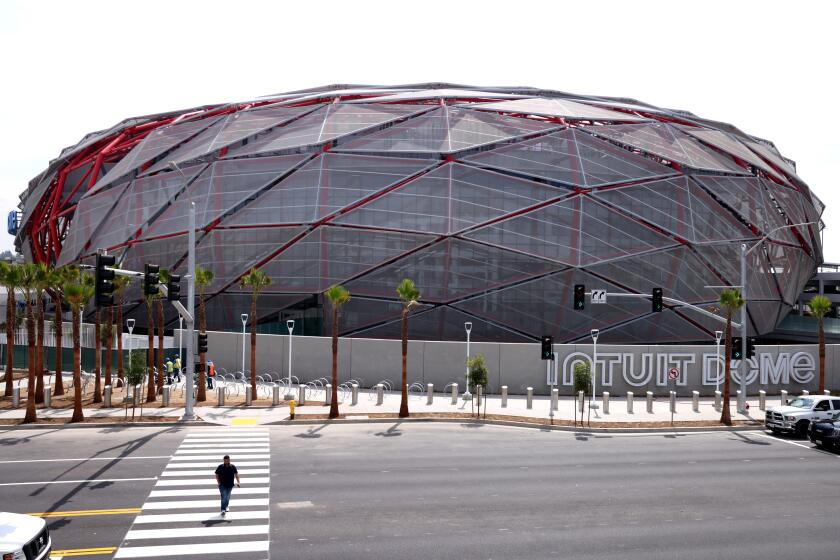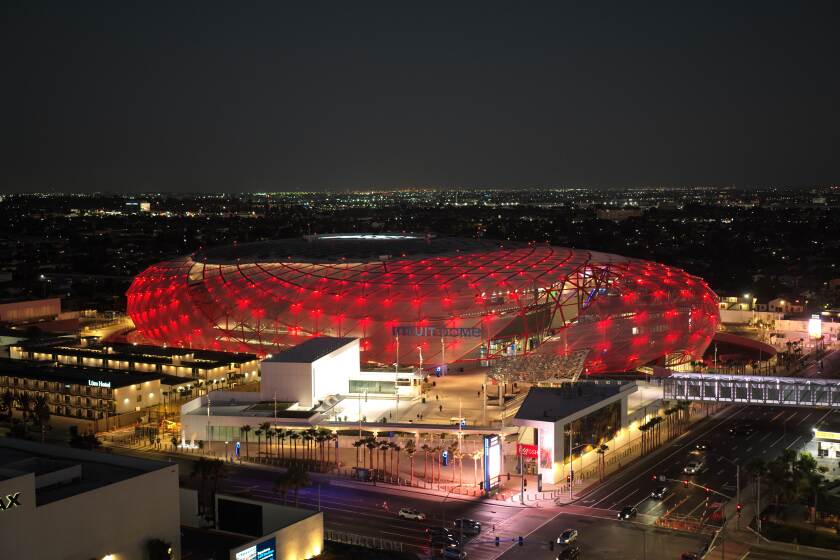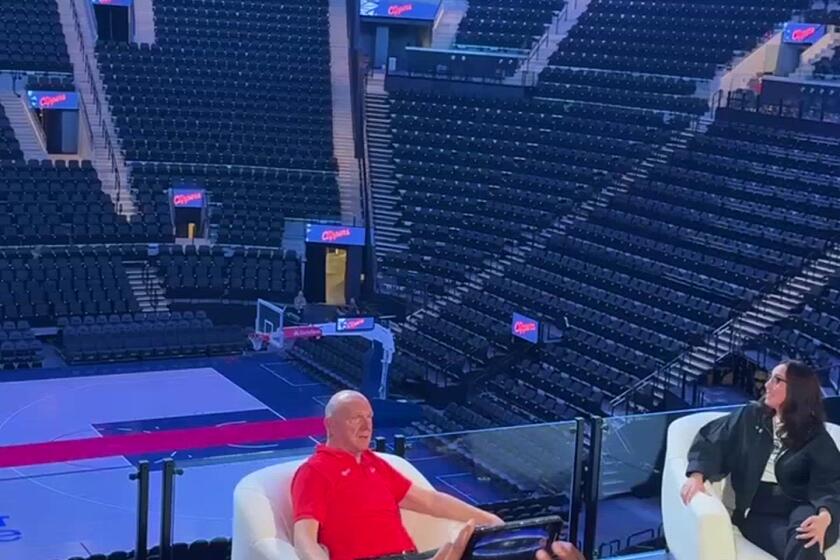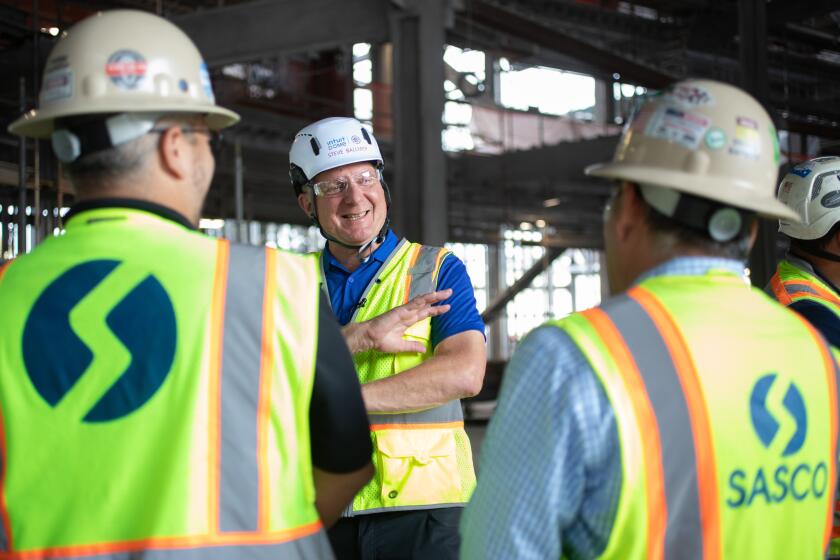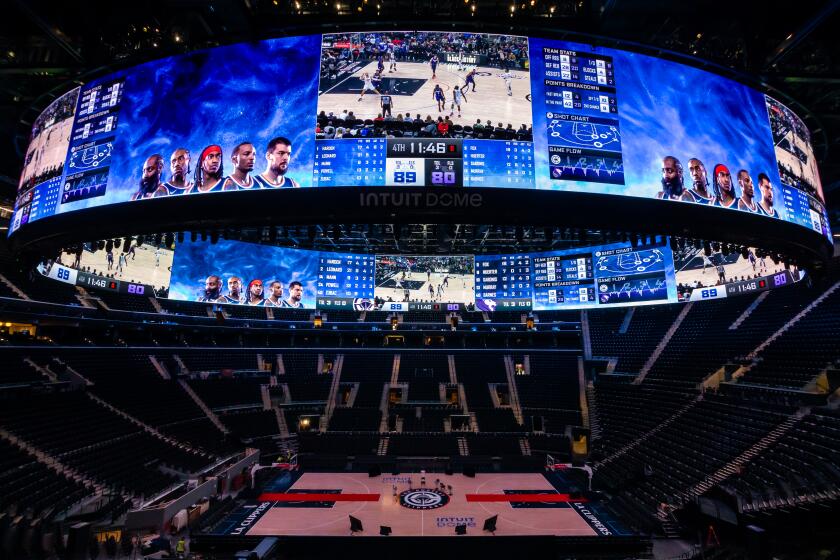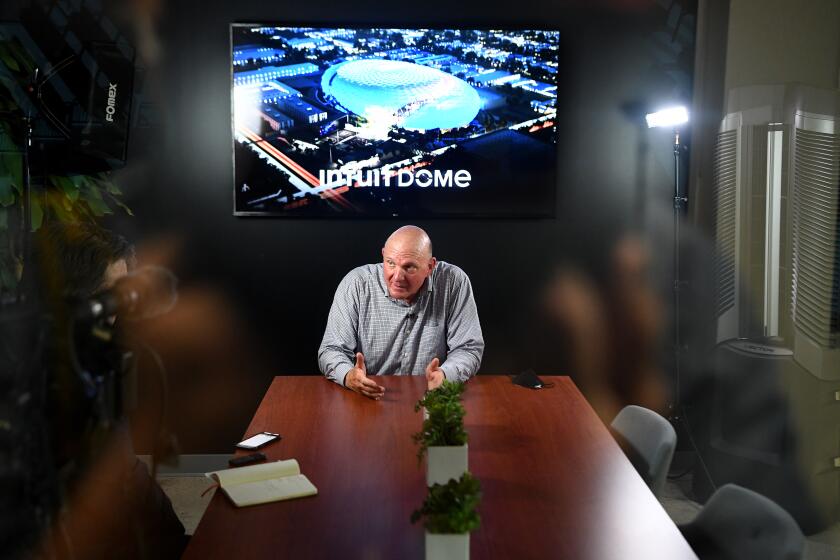
- Share via
For Dan Kennedy, the odd thing about his homecoming was how it never quite felt like home.
When the goalkeeper was signed by Chivas USA in 2008, the club was one of the two Major League Soccer franchises in Los Angeles, and Kennedy was a local talent raised in Orange County who had later starred at UC Santa Barbara.
The Clippers open the 2024-25 NBA season at the Intuit Dome, their new $2-billion arena. Here is complete coverage of the game and the arena’s facilities.
By the time Chivas folded six seasons later, no one had appeared in more games or played more minutes in its history than Kennedy. Yet in all that time, he said, he often felt more comfortable playing on the road.
The Galaxy, the original tenant in the Carson stadium that housed both teams, had two training fields to Chivas’s one. The shared weight room was painted in Galaxy colors. The Galaxy’s schedule featured prime-time dates, where Chivas played weekend matinees. Chivas branding was visible on match day, but quickly taken down.
“When they weren’t having success, I would say it was certainly less bothersome,” Kennedy said. “But when they were rolling and winning championships, we were trying to figure out what this club was even going to be -- if it was going to continue in Major League Soccer. And it was so evident that we just didn’t have a home, and didn’t have identity, and we were just second fiddle.”
There’s a term for that kind of stadium-sharing: groundshare. Yet unofficially, such co-tenants often call it something different: a total drag.
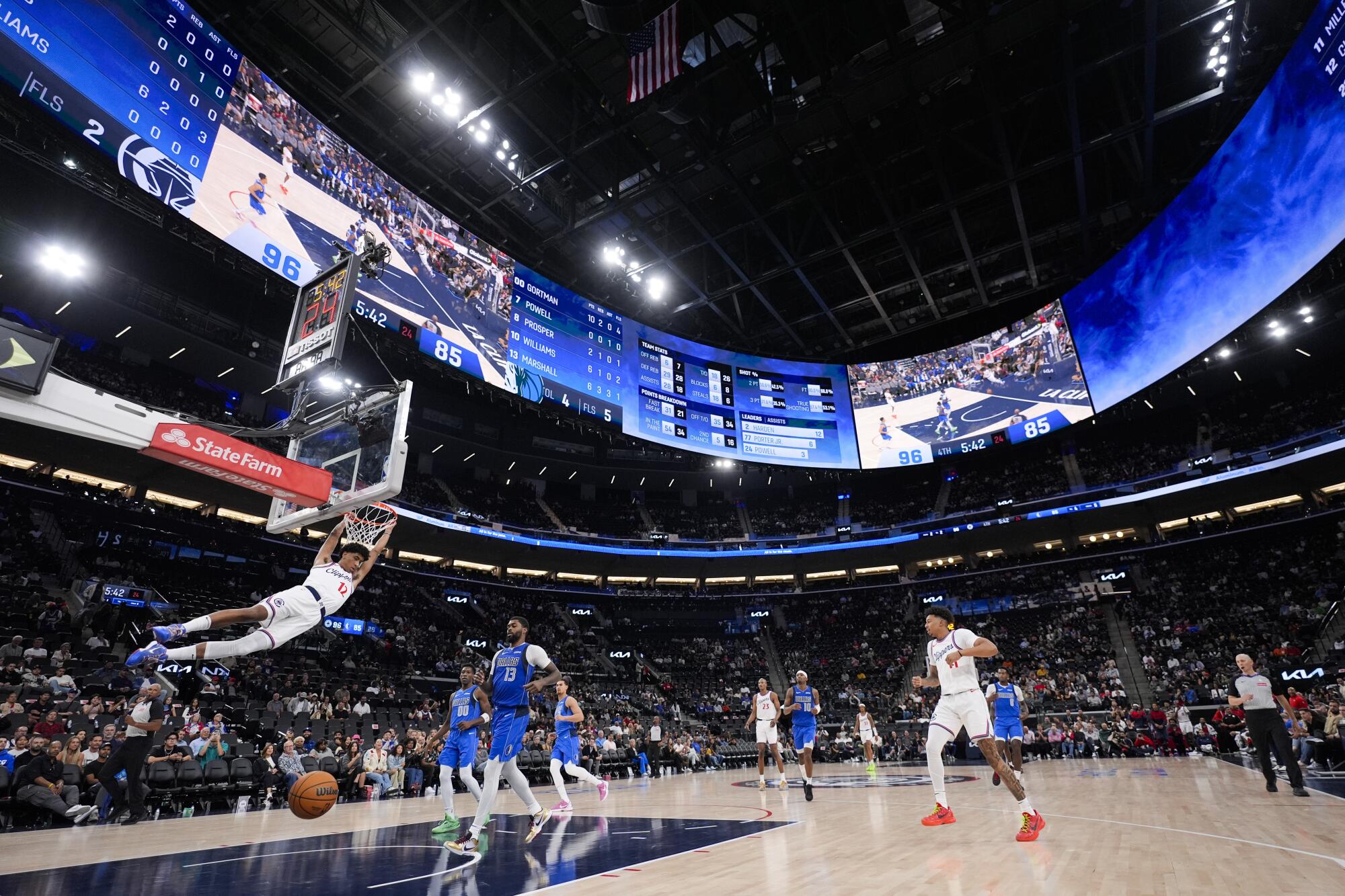
Born out of convenience, the arrangements often lose their appeal for reasons that range from financial, logistical or cultural.
No one needs to explain that to the Clippers, who spent their first 40 years in Los Angeles as a roommate. After 15 years sharing the Sports Arena with USC basketball, the NBA franchise spent the last 25 as the third tenant at Crypto.com Arena, behind the Kings and Lakers in the pecking order for preferential dates.
Now, that is no longer the case. On Wednesday, the Clippers will host their first regular-season NBA game at Intuit Dome, in Inglewood, whose $2-billion-plus construction bill was footed by Steve Ballmer, the tech billionaire. Upon buying the team in 2014, Ballmer didn’t initially believe it needed new digs. Within a year, however, Ballmer began asking himself something that everyone involved in groundshare ponders, at some point.
What’s the value of having a home to call one’s own?
The answer can mean different things to different stakeholders. But few were even asking that question in the 1960s and 70s, as a new trend swept across the U.S.
From Seattle’s Kingdome to RFK Stadium in Washington D.C., cavernous, municipal-owned stadiums were erected that could house both football and baseball. It was a uniquely North American boom; in Europe, shared stadiums like the famed San Siro, where both of Milan’s top soccer clubs play, are the exception.
“It just seemed like the cost prudent thing to do,” said J.C. Bradbury, an economist at Kennesaw State University. “Hey, we’re going to build one for baseball and football, basketball and hockey. Boom, that’s done. And what happened is, you did end up with a lot of these second-class tenants in these facilities.”
Intuit Dome is a sleek, joyous piece of modern architecture with much to love, just like its neighbor, SoFi Stadium. But around its edges, the picture gets a little fuzzier.
By the 1990s, as the older stadiums’ decades-long leases came up, those tenants wanted out, and in the process, ushered in a new era of single-team stadium construction —-- bespoke buildings of brick or steel, designed with just one team in mind.
To team owners who build such stadiums financed either in part or in whole by public money, the value was obvious: control over new revenue streams and design for buildings paid for using only a fraction of their own wealth. In one such case, according to a review of public policy toward stadium construction that Bradbury co-authored last year, the Atlanta Falcons received $200 million in bonds to build the new stadium it opened in 2017, as well as revenue from a hotel tax worth hundreds of million more it could keep even after the bonds were paid off.
For the public, the payoff was often murkier. Bradbury and his co-authors analyzed, in no uncertain terms, that “no economic justification exists for subsidizing professional sports venues at observed levels.” Looking for value beyond the bottom line, they also collected studies that attempted to measure intangible social benefits from living in a city with a pro team. That level of value-add that researchers were trying to identify was often difficult to quantify — property values near stadiums, one measure, didn’t soar — but also not non-existent.
In Columbus, Ohio, such value was evident from the start for Jamey Stang.
Stang grew up in Ohio as the son of soccer-loving German immigrants. He traveled around the Midwest watching his father play for a local German social group, and spent weekends in vain trying to find highlights of European games. By 1994, Stang was a recent college graduate when he heard Columbus had earned an MLS franchise, and was so enthusiastic that he went door-to-door to canvas for a tax levy intended to fund a new Columbus Crew stadium.
“I was going to get to watch true professional soccer in the city that I lived in,” Stang said, “and I was ecstatic about it.”
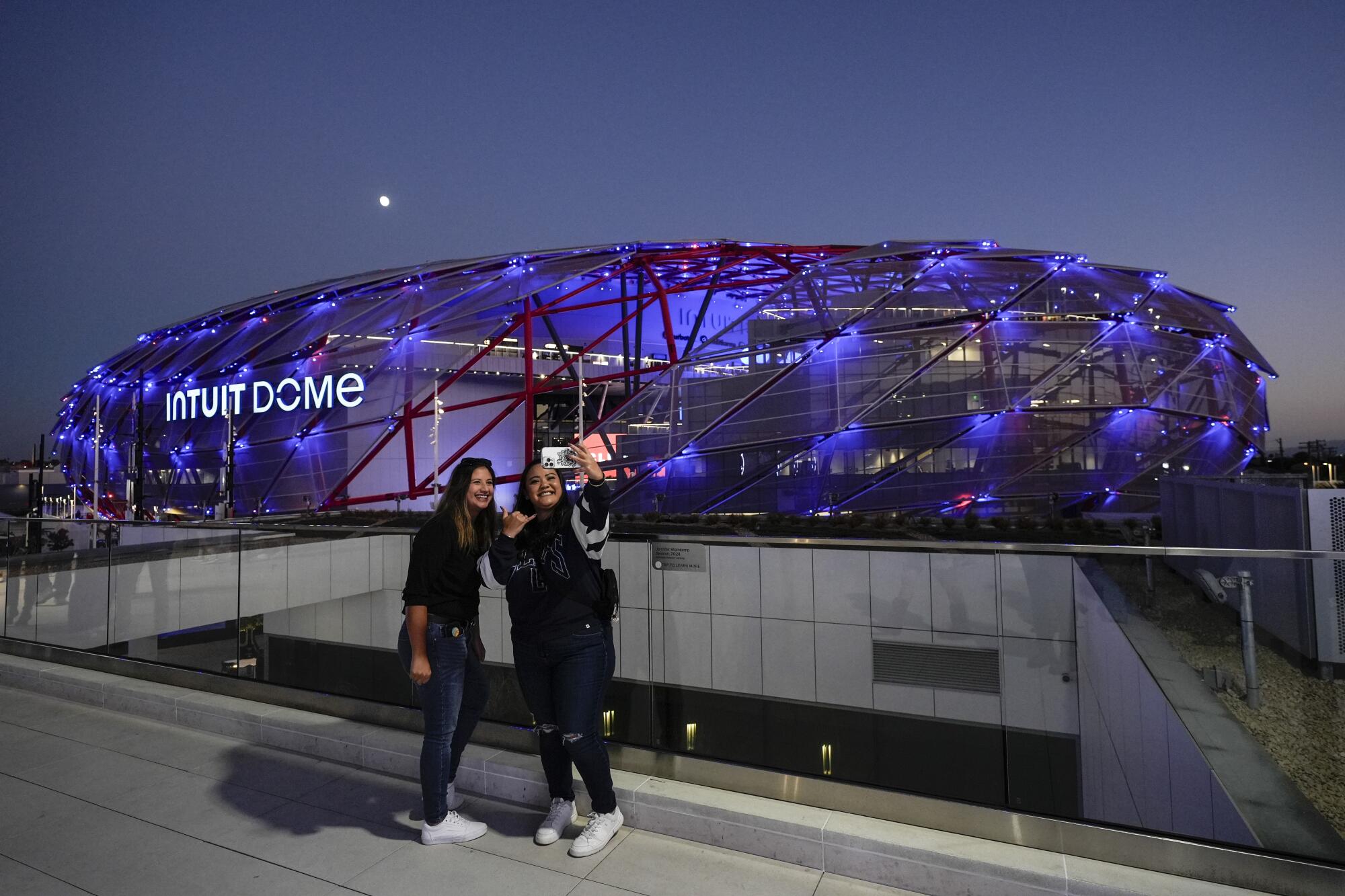
For three years, the Crew temporarily shared Ohio Stadium, the home of Ohio State football, an experience that was both impersonal and highly personal. Even the Crew’s biggest games barely made a dent in the stadium’s capacity, and yet the city’s soccer community was so small, Stang felt he knew just about every supporter in the stands. After games, he and other fans mingled with players at a bar across the street.
The Crew’s new stadium, which opened in 1999, looked like a hunk of metal that lived up to its derisive nickname, “The Erector Set.” Located in a muddy lot on the state fairgrounds, it was far from downtown, restaurants and bars. But it had tailgating and built an intense connection between those who showed up, Stang said. In 2006, he began bringing his daughter, then 7, to sit together in the rowdy supporters section, where fan groups banged drums and held aloft a giant banner known as “tifo.” She took pictures with players like Brian McBride.
Clippers owner Steve Ballmer, CEO of Halo Sports and Entertainment Gillian B.
If the stadium had its drawbacks, it was also a pioneer — the first soccer-specific pro stadium in the U.S., one that kicked off yet another new wave of construction. (The Galaxy’s Carson home opened four years later.) When MLS started in the mid-1990s, its original business plan called for its teams playing as a secondary tenant in someone else’s stadium.
Flipping that expectation has helped grow the league’s popularity and keep it viable, MLS commissioner Don Garber told The Times.
“The ability to see the game the way that it’s supposed to be seen from the stands, and also the fact that other people who might not have been soccer fans saw the way that the investment was being made in the league, I think both those things together were able to help save the league,” Stang said.
The league’s desire to avoid a Chivas-level mistake was so apparent that when it folded and the league announced a new L.A. franchise, LAFC, it stipulated that the team wouldn’t begin play until its own stadium could be completed. At $350 million, LAFC’s stadium opened as the most expensive soccer-specific stadium in the league’s history. Of the 29 teams now in MLS, 22 play in soccer-specific stadiums. At July’s All-Star break, the league reported an average attendance of more than 23,000, the highest at that point in its history, with stadiums at a record 94% of capacity.
It was a four-mile move into a tiny stadium.
Jana Woodson remembers it as a huge deal.
In 2009, the University of Richmond’s football team left behind City Stadium, the 22,000-seat municipal field it had shared with a lower-division professional soccer team for 14 years, for an 8,700-seat home, built with $25 million in university and donor money, that was on-campus and all their own. The capacity was about 700 seats smaller than their previous season’s average crowd size, yet it sparked a surge in revenue, “greatly increasing the number of season tickets we got,” along with donations, said Woodson, an assistant athletics director for marketing and fan development.
When Woodson joined Tulane University as a deputy athletic director in 2017, she saw something similar happening. Three years earlier, the New Orleans university opened Yulman Stadium to return football to campus after 39 years playing at the city’s 83,000-seat downtown Superdome. In 2013, its final Superdome season, Tulane averaged 19,747 fans. As in MLS, college teams have left behind large stadiums for bespoke buildings that are described in the industry with a buzzword — “right-sized.”
Clippers owner Steve Ballmer is determined to give fans the best experience they’ve ever had at an NBA arena. Will he achieve his dream?
An on-campus stadium isn’t a shortcut to on-field success. It took the Green Wave five seasons in their new stadium to produce a winning record. But in the last six years, the Green Wave have produced four winning seasons — as many as in their previous 21 seasons. In 2022, their 12-2 season finished with a Cotton Bowl victory over USC and a top-25 rankings for the first time since 1998. Woodson couldn’t directly connect the stadium to that turnaround, but did contend that its connection to campus life — the stadium shared a concourse with other athletic facilities — was reinvigorating.
Game days that once sent students and alumni three miles away from campus now brought them back to campus, where “people are excited to come because that’s where their heart is, right?” Woodson said. “College athletics is about, for alumni and fans, the university … and it’s nostalgic to come back.”
Continuing that momentum is hard. Just ask the Minnesota Twins and Minnesota Golden Gophers football, who shared the Metrodome with the NFL’s Vikings for decades before opening their own stadiums in 2010 and 2009, respectively. Both watched attendance spike in the first few seasons in their new homes, only to flatline to Metrodome-era levels.
That trend experienced by some teams hasn’t daunted others. In November, the University of South Florida will break ground on a 35,000-seat on-campus stadium that is projected to cost $340 million. Since the school started playing football in 1997, its home field has been about 11 miles south of campus at the home of the NFL’s Tampa Bay Buccaneers. There, terms of their lease allow the Bulls to earn revenue from ticket sales and limited sponsorships, but not a cut from premium-seat sales, the parking lots, or concessions, said Michael Kelly, USF’s athletic director.
The Clippers got their first real home schedule on Thursday, with a 2024-25 schedule released. The team will host Paul George on Nov. 6.
As with Tulane, playing in an NFL facility had been a selling point in recruiting, but sharing had lost its luster with the school and its board of trustees who watched as rivals such as Central Florida built their own stadiums and saw, in general, donations to those schools rise. Kelly hailed the new building as a “tool for engagement” for the school’s 400,000 alumni.
“I kind of keep thinking it’s like a 26-year-old still living in their parents’ basement,” Kelly said. “It’s fine, and save some rent and stuff but sooner or later you got to move out and do your own thing.”
Though the push for a new USF stadium began long before tectonic plates holding together college athletics began shaking — from rampant conference realignment to a House settlement that will soon allow schools to share revenue with their own athletes — Kelly acknowledged that it also doesn’t hurt public perception to have a shiny new stadium act as a billboard to either recruits or conference executives.
“To revenue share, you have to have revenues to share, right?” Kelly said. “And to be able to build the tools that we need to raise more money, to engage more with the community, to have the revenue streams like a stadium can provide, it will undoubtedly provide some of those economic engines.”
If groundshare is going out of style — the Dallas Mavericks and Philadelphia 76ers, who both share home stadiums with NHL teams, have made noise about opening new stadiums — it also is not dead.
Despite a push to build a stadium on Manhattan’s West Side two decades ago, the New York Jets, who have been co-tenants for their entire existence, still share MetLife Stadium with the NFL’s Giants. And in 2020, the Rams and Chargers left behind temporary but separate homes at USC’s Coliseum and the Galaxy’s Dignity Health Sports Park to move into Inglewood’s SoFi Stadium.
Clippers owner Stever Ballmer wants Los Angeles critics to know his team isn’t going anywhere. He’s building an elite arena and a roster capable of winning championships.
One year after construction wrapped on SoFi that brought together the NFL franchises, the Clippers held the groundbreaking for Intuit Dome just across West Century Boulevard, the first step in their downtown divorce from the Lakers and Kings. For 40 years, the Clippers lived a fragmented existence, with their business office downtown, a short walk from Crypto.com Arena, while their basketball staff worked and the team practiced 14 miles away, in Playa Vista. When it came time to build their own arena, the owner ordered up outdoor plazas and community spaces on the arena’s 26-acre site in an attempt to recreate the feel of a campus, where fans can and want to visit even on days without games.
The dome won’t be immune from what Bradbury called “spillover effects” on the surrounding area, such as increased traffic, noise or crime. But the economist said that when viewing a pro team as a private business looking to spur revenue through a new location, no different than a grocery store or restaurant, moving the team through private funding was the most “desirable” of options for stadium construction.
“Some of [moving the team to Inglewood] may be for the community,” Bradbury said. “I do think that when you’re fabulously wealthy and own a sports team, maybe you might just say, hey, my fans deserve better, and I got money to do that, why not? But I suspect, as in most cases, owners rarely make decisions that are not in their financial interest, and they normally end up paying off.”
Ballmer spent upward of $2 billion on the complex, but speaks of a payoff that is as much cultural as commercial. Inside the team, small customs such as walking into the building and giving a fist bump to the same attendant at the front desk, are talked about as the type of details that turn home -court into an advantage. Time will tell.
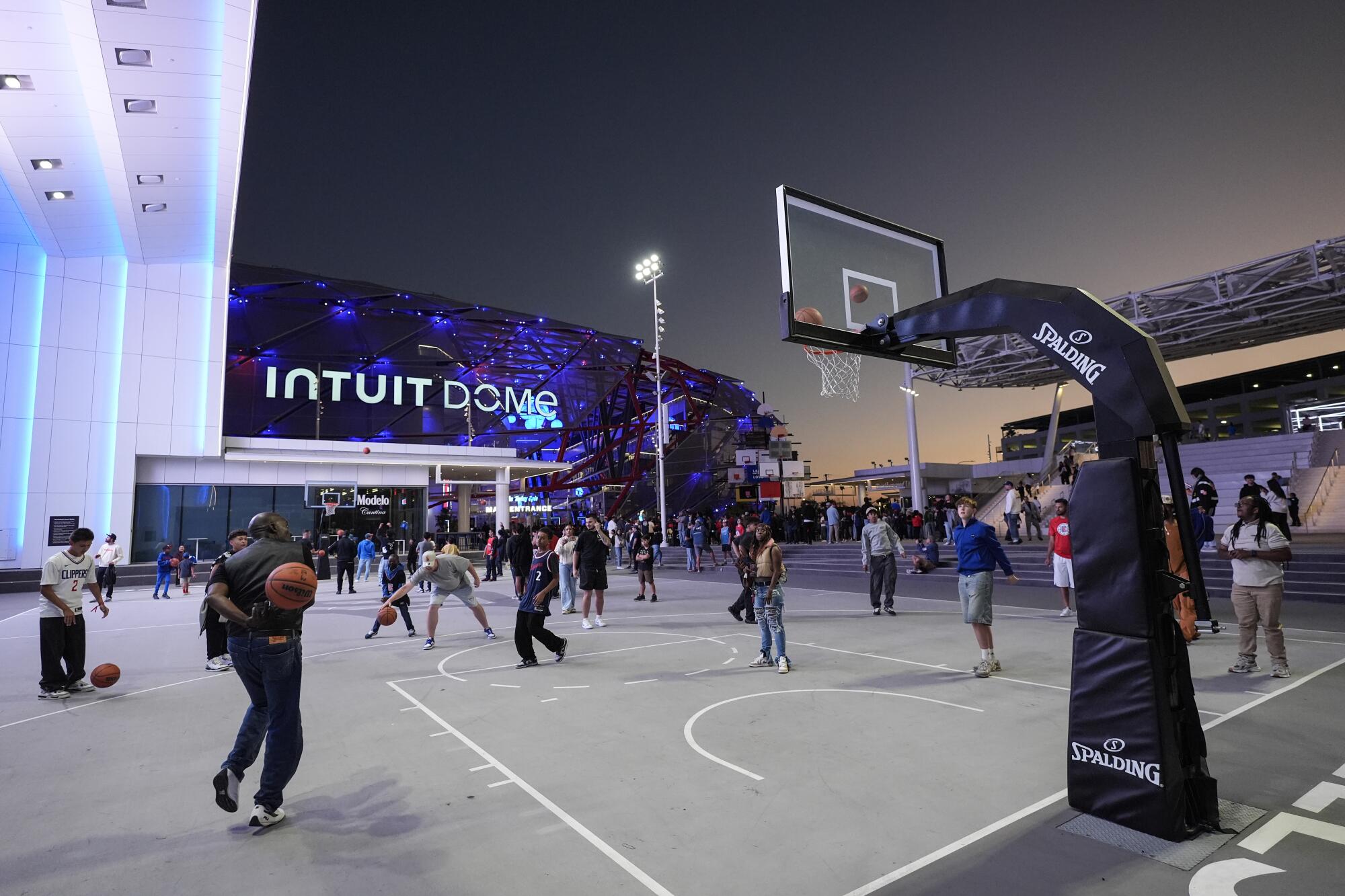
Kennedy felt that difference at the end of his MLS career when he returned to Los Angeles in 2015 to play for the Galaxy.
“You come into the same stadium, but yet have a completely different player experience,” Kennedy said.
He still wonders what might have happened had Chivas gotten its own L.A. stadium, a project Kennedy said Shawn Hunter, the president and chief executive of Chivas USA, was working on during their overlap at the club. (Through the minor-league baseball team he has since founded, Hunter could not be reached for comment.) Not having their own stadium didn’t lead to the club’s folding in 2014 alone, Kennedy said, but it certainly didn’t help.
“Pro sports in the United States now is a massive real estate play,” Kennedy said. “We’ve seen it time and time again: If you create a home atmosphere that’s special it just becomes a tougher place to play across any sport. You get a hot playoff team at home with great fan support, they’re going to have a little bit of an advantage.”
More to Read
Get our high school sports newsletter
Prep Rally is devoted to the SoCal high school sports experience, bringing you scores, stories and a behind-the-scenes look at what makes prep sports so popular.
You may occasionally receive promotional content from the Los Angeles Times.

